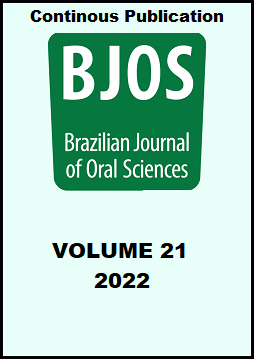Abstract
Aim: The aim of the present study was to evaluate the microbial contamination in internal and external walls of cone morse implant walls. Methods: Eleven patients with edentulous mandibular posterior area were selected to received dental implants, divided into groups: submerged (S), non-submerged (NS), and immediately loaded (IL). Microbiological evaluations (microorganisms’ number, aerobic and anaerobic colony forming units (CFU) number and microorganisms’ qualification) were divided into internal and external collection of the implant walls, at different stages: T0 (surgical procedure), T2 (suture removal), T4 (reopening S group), T6 (suture removal S group), and T8 (abutment placement in S and NS). All data were submitted to statistical analyses, with confidence level of 0.05. Results: There was difference in number of microorganisms observed over time within the same group (p < 0.05). A difference was observed in CFU when evaluated within the same group over time (p < 0.05), except for the IL group. In internal collection, a predominance of non-formation of microorganisms was observed at T0 in all groups, while formation of Gram-positive Diplococci and Gram-positive Bacilli was observed at T8 (p>0.05). In external collection, an increase in number of microorganisms was observed at T0. Conclusion: There was no difference in microbial contamination among the evaluated groups. The microorganism’s colonization changed over time.
References
Palaska I, Tsaousoglou P, Vouros I, Konstantinidis A, Menexes G. Influence of placement depth and abutment connection pattern on bone remodeling around 1-stage implants: a prospective randomized controlled clinical trial. Clin Oral Implants Res. 2016 Feb;27(2):e47-56. doi: 10.1111/clr.12527.
Collaert B, De Bruyn H. Comparison of Brånemark fixture integration and short-term survival using one-stage or two-stage surgery in completely and partially edentulous mandibles. Clin Oral Implants Res. 1998 Apr;9(2):131-5. doi: 10.1034/j.1600-0501.1998.090209.x.
Branemark PI, Hansson BO, Adell R, Breine U, Lindstrom J, Hallen O, et al. Osseointegrated implants in the treatment of the edentulous jaw. Experience from a 10-year period. Scand J Plast Reconstr Surg Suppl. 1977;16:1-132.
Calvo-Guirado JL, Lopez-Lopez PJ, Mate Sanchez JE, Gargallo Albiol J, Velasco Ortega E, Delgado Ruiz R. Crestal bone loss related to immediate implants in crestal and subcrestal position: a pilot study in dogs. Clin Oral Implants Res. 2014 Nov;25(11):1286-94. doi: 10.1111/clr.12267.
Negri B, Lopez Mari M, Mate Sanchez de Val JE, Iezzi G, Bravo Gonzalez LA, Calvo Guirado JL. Biological width formation to immediate implants placed at different level in relation to the crestal bone: an experimental study in dogs. Clin Oral Implants Res. 2015 Jul;26(7):788-98. doi: 10.1111/clr.12345.
Ericsson I, Randow K, Glantz PO, Lindhe J, Nilner K. Clinical and radiographical features of submerged and nonsubmerged titanium implants. Clin Oral Implants Res. 1994 Sep;5(3):185-9. doi: 10.1034/j.1600-0501.1994.050310.x.
Giacomel MC, Camati P, Souza J, Deliberador T. Comparison of marginal bone level changes of immediately loaded implants, delayed loaded nonsubmerged implants, and delayed loaded submerged implants: a randomized clinical trial. Int J Oral Maxillofac Implants. 2017;32(3):661-6. doi: 10.11607/jomi.5353.
Jansen VK, Conrads G, Richter EJ. Microbial leakage and marginal fit of the implant-abutment interface. Int J Oral Maxillofac Implants. 1997;12(4):527-40.
Peruzetto WM, Martinez EF, Peruzzo DC, Joly JC, Napimoga MH. Microbiological seal of two types of tapered implant connections. Braz Dent J. 2016 May-Jun;27(3):273-7. doi: 10.1590/0103-6440201600604.
Canullo L, Penarrocha-Oltra D, Soldini C, Mazzocco F, Penarrocha M, Covani U. Microbiological assessment of the implant-abutment interface in different connections: cross-sectional study after 5 years of functional loading. Clin Oral Implants Res. 2015 Apr;26(4):426-34. doi: 10.1111/clr.12383.
Jervøe-Storm PM, Jepsen S, Jöhren P, Mericske-Stern R, Enkling N. Internal bacterial colonization of implants: association with peri-implant bone loss. Clin Oral Implants Res. 2015 Aug;26(8):957-63. doi: 10.1111/clr.12421.
Khan SZ, Sasaki n, Sasaki N, Sasaki K, Inoue T, Kenichi M. Detection of predominant subgingival periopathogens around submerged and non-submerged hydroxy-apatite implants. J Dent Implants. 2013 Jan;3(2):111. doi: 10.4103/0974-6781.118884.
Mombelli A, Décaillet F. The characteristics of biofilms in peri-implant disease. J Clin Periodontol. 2011 Mar;38 Suppl 11:203-13. doi: 10.1111/j.1600-051X.2010.01666.x.
Chrcanovic BR, Albrektsson T, Wennerberg A. Immediately loaded non-submerged versus delayed loaded submerged dental implants: a meta-analysis. Int J Oral Maxillofac Surg. 2015 Apr;44(4):493-506. doi: 10.1016/j.ijom.2014.11.011.
Proff P, Steinmetz I, Bayerlein T, Dietze S, Fanghänel J, Gedrange T. Bacterial colonisation of interior implant threads with and without sealing. Folia Morphol (Warsz). 2006 Feb;65(1):75-7.
de Moraes Rego MR, Torres MF, Santiago LC, Lira-Junior R, Lourenço EJ, de Moraes Telles D, et al. Osseointegrated implants placed at supracrestal level may harbour higher counts of A. gerencseriae and S. constellatus - a randomized, controlled pilot study. J Oral Microbiol. 2015 Oct 23;7:27685. doi: 10.3402/jom.v7.27685.
Cosyn J, Van Aelst L, Collaert B, Persson GR, De Bruyn H. The peri-implant sulcus compared with internal implant and suprastructure components: a microbiological analysis. Clin Implant Dent Relat Res. 2011 Dec;13(4):286-95. doi: 10.1111/j.1708-8208.2009.00220.x.
Broggini N, McManus LM, Hermann JS, Medina RU, Oates TW, Schenk RK, et al. Persistent acute inflammation at the implant-abutment interface. J Dent Res. 2003 Mar;82(3):232-7. doi: 10.1177/154405910308200316.
Peruzetto WM, Martinez EF, Peruzzo DC, Joly JC, Napimoga MH. Microbiological seal of two types of tapered implant connections. Braz Dent J. 2016 May-Jun;27(3):273-7. doi: 10.1590/0103-6440201600604.
Preethanath RS, AlNahas NW, Bin Huraib SM, Al-Balbeesi HO, Almalik NK, Dalati MHN, et al. Microbiome of dental implants and its clinical aspect. Microb Pathog. 2017 May;106:20-4. doi: 10.1016/j.micpath.2017.02.009.
Belibasakis GN, Manoil D. Microbial community-driven etiopathogenesis of peri-implantitis. J Dent Res. 2021 Jan;100(1):21-8. doi: 10.1177/0022034520949851.

This work is licensed under a Creative Commons Attribution 4.0 International License.
Copyright (c) 2021 Fabio Furquim, Tatiana Miranda Deliberador, Maria Cecilia Lopes Giacomel, Suyany Gabriely Weiss, João César Zielak, Rafaela Scariot


